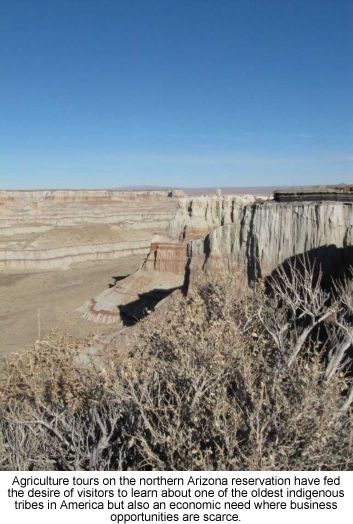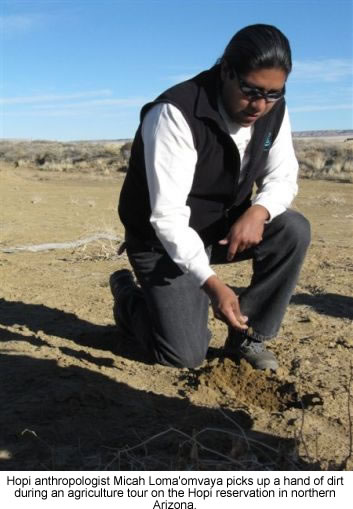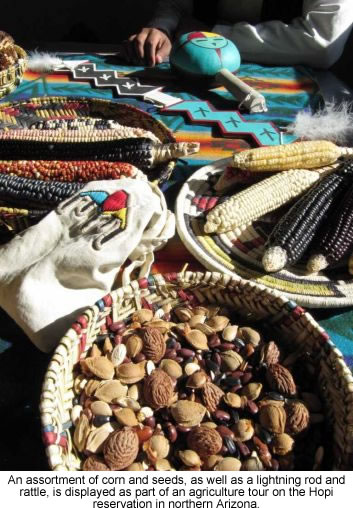 |
Canku Ota
|
 |
|
(Many Paths)
|
||
|
An Online Newsletter
Celebrating Native America
|
||
|
June
1, 2011 - Volume 9 Number 6
|
||
|
|
||
|
Hopi Agriculture
Tours Showcase Tribe's Culture
|
||
 BACAVI,
Ariz. — The small plots below the curve of a steep gravel road
seem an unlikely place to grow crops, as does the sandy slope near
a busy freeway and the cliff side of a tribal village. BACAVI,
Ariz. — The small plots below the curve of a steep gravel road
seem an unlikely place to grow crops, as does the sandy slope near
a busy freeway and the cliff side of a tribal village.
Hopis know that these places aren't the most accessible, but it's here where the staples of traditional food — corn, squash and beans — flourish with what little water reaches the usually dry land. It's a farming technique that has been practiced for centuries as part of a belief that a prosperous life comes through hard work. Micah Loma'omvaya shares those stories as a part of a tour he leads to the Hopi mesas that rise above the northern Arizona desert, giving visitors a glimpse of Hopi tradition and culture that's rooted in agriculture. The tours have fed the desire of visitors to learn about one of the oldest indigenous tribes in America but also an economic need where business opportunities are scarce. "There are a lot of discussions on Hopi on ideas of how we can capitalize on the things we have, and tourism is one of them," said Cliff Quotsaquahu, a research assistant in the tribe's Office of Community Planning and Economic Development. Standing amid salt bushes that Hopis use in stews, Loma'omvaya points to a coal seam running through a rugged canyon in the distance. The tribal government is largely dependent on coal revenues that make up the majority of its non-federal budget. Half of the work force is unemployed. About 20 percent of tribal members who make a living off selling arts and crafts from their homes or roadside stands don't figure into that statistic, Quotsaquahu said.
"Limited access to any economic development centers is an understatement," tribal chairman Le Roy Shingoitewa recently told members of Congress. Curiosity in the history of the Hopis, who are known to have been in Arizona for 2,000 years, gives tribal members like Loma'omvaya an avenue for income. Tourists see hundreds of petroglyphs, are greeted by farmers at terraced gardens and corn fields and hear about the preservation of ancient seeds crops. Loma'omvaya, an anthropologist, carries around historic photos with plowing equipment sitting outside stone homes, fruit trees dotting the reservation and high water levels in springs. He ferries tourists across the reservation in his pickup truck, playing Native music and pointing out geographical features. These tours have been ongoing since 1540, he says half-jokingly. That's the year Hopis directed Spanish conquistadors and their guides to the Grand Canyon. The Hopi admittedly want to keep tourism operations small-scale. "There hasn't been this much accessibility to the Hopi culture in a long time," said James Surveyor, the marketing and sales associate at the Moenkopi Legacy Inn & Suites on the reservation. "As that keeps going, we're going to get more people into Hopi. We don't look at a future where we want charter bus after charter bus like the Grand Canyon."
Across the Hopi reservation, newly plowed fields with corn planted deep down await moisture. Part of Hopi belief is that they are stewards of the land. A higher being handed down a bag of seeds, a water gourd and a planting stick along with a promise of a hard and enduring but prosperous life from farming, said Leland Dennis, coordinator of the Natwani Coalition that focuses on preserving the agriculture tradition. Ceremonies, songs and cultural activities are tied directly to agriculture with prayers for rain and a fertile harvest. Prayer sticks with feathers hang from stones that support terraced gardens, and Hopi art commonly features rain clouds. "That's the simplest of pleasures that we forget in our commodity-driven society when we want the latest iPod, vehicle and the best shoes," Surveyor said. "That prayer, that ceremony, that belief is all intertwined with farming because farming is what the people are." |
|
|
||
|
|
||
| Canku Ota is a free Newsletter celebrating Native America, its traditions and accomplishments . We do not provide subscriber or visitor names to anyone. Some articles presented in Canku Ota may contain copyright material. We have received appropriate permissions for republishing any articles. Material appearing here is distributed without profit or monetary gain to those who have expressed an interest. This is in accordance with Title 17 U.S.C. Section 107. | ||
|
Canku Ota is a copyright ©
2000, 2001, 2002, 2003, 2004, 2005, 2006, 2007, 2008, 2009, 2010,
2011 of Vicki Barry and Paul Barry.
|
||
 |
 |
|
|
The "Canku
Ota - A Newsletter Celebrating Native America" web site and
its design is the
|
||
|
Copyright ©
1999, 2000, 2001, 2002, 2003, 2004, 2005,
2006, 2007, 2008, 2009, 2010, 2011
of Paul C. Barry.
|
||
|
All Rights Reserved.
|
||
 The
lack of infrastructure on the 1.6 million-acre reservation that's
landlocked by the much-larger Navajo Nation means industrial development
is nonexistent. An industrial park that the tribe owns off the reservation
once churned out underwear and baseball caps but now is vacant.
Tribal members have twice rejected gaming.
The
lack of infrastructure on the 1.6 million-acre reservation that's
landlocked by the much-larger Navajo Nation means industrial development
is nonexistent. An industrial park that the tribe owns off the reservation
once churned out underwear and baseball caps but now is vacant.
Tribal members have twice rejected gaming. Nearby
tribes also have seen the benefits of tourism. The Hualapai in northwestern
Arizona just celebrated 23 years in the industry with destinations
that now include the Grand Canyon Skywalk. The Navajo Nation draws
tourists with Canyon de Chelly National Monument, Monument Valley
and other tribal parks.
Nearby
tribes also have seen the benefits of tourism. The Hualapai in northwestern
Arizona just celebrated 23 years in the industry with destinations
that now include the Grand Canyon Skywalk. The Navajo Nation draws
tourists with Canyon de Chelly National Monument, Monument Valley
and other tribal parks.